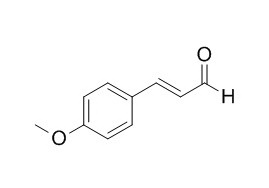4-Methoxycinnamaldehyde
4-Methoxycinnamaldehyde can inhibit human respiratory syncytial virus(RSV) in a human larynx carcinoma cell line, it may be helpful to manage the disease induced by RSV infection. trans-4-Methoxycinnamaldehyde shows potent nematicidal activity.
Inquire / Order:
manager@chemfaces.com
Technical Inquiries:
service@chemfaces.com
Tel:
+86-27-84237783
Fax:
+86-27-84254680
Address:
1 Building, No. 83, CheCheng Rd., Wuhan Economic and Technological Development Zone, Wuhan, Hubei 430056, PRC
Providing storage is as stated on the product vial and the vial is kept tightly sealed, the product can be stored for up to
24 months(2-8C).
Wherever possible, you should prepare and use solutions on the same day. However, if you need to make up stock solutions in advance, we recommend that you store the solution as aliquots in tightly sealed vials at -20C. Generally, these will be useable for up to two weeks. Before use, and prior to opening the vial we recommend that you allow your product to equilibrate to room temperature for at least 1 hour.
Need more advice on solubility, usage and handling? Please email to: service@chemfaces.com
The packaging of the product may have turned upside down during transportation, resulting in the natural compounds adhering to the neck or cap of the vial. take the vial out of its packaging and gently shake to let the compounds fall to the bottom of the vial. for liquid products, centrifuge at 200-500 RPM to gather the liquid at the bottom of the vial. try to avoid loss or contamination during handling.
J Food Sci Technol.2022, 59(1):212-219.
Molecules.2021, 26(9):2765.
Nat Commun.2023, 14(1):8142.
Molecules.2024, 29(5):1048.
Journal of Analytical Chemistry2017, 854-861
University of Manitoba2023, 37433.
Food Funct.2020, 11(2):1322-1333.
Molecules.2019, 24(1):E159
Mediators Inflamm.2016, 2016:7216912
J of the Society of Cosmetic Scientists of Korea2018, 44(4):407-417
Related and Featured Products
Phytomedicine. 2009 Sep;16(9):882-6.
4-Methoxycinnamaldehyde inhibited human respiratory syncytial virus in a human larynx carcinoma cell line.[Pubmed:
19303275]
METHODS AND RESULTS:
4-Methoxycinnamaldehyde, an active constituent of Agastache rugosa, was examined for its cytoprotective activity against RSV by XTT method in human larynx carcinoma cell line. 4-Methoxycinnamaldehyde could effectively inhibit cytopathic effect of RSV (p<0.0001) with an estimated IC(50) of 0.055microg/ml and a selectivity index (SI) of 898.2. 4-Methoxycinnamaldehyde (0.03microg/ml) could inhibit viral entrance by interfering viral attachment (IC(50) of 0.06microg/ml; p<0.0001) and internalization (IC(50) of 0.01microg/ml; p<0.0001). 4-Methoxycinnamaldehyde significantly increased the basal production of IFN (p=0.0015), but not the virus-induced IFN production. Therefore, its cytoprotective activity against RSV was not mediated by interferon.
CONCLUSIONS:
In conclusion, 4-Methoxycinnamaldehyde might be helpful to manage the disease induced by RSV infection.
J Nematol. 2007 Mar;39(1):31-6.
Nematicidal Activity of Cassia and Cinnamon Oil Compounds and Related Compounds toward Bursaphelenchus xylophilus (Nematoda: Parasitaphelenchidae).[Pubmed:
19259472 ]
METHODS AND RESULTS:
The nematicidal activity of two cassia, Cinnamomum cassia, oils (Especial and true), four cinnamon, Cinnamomum zey-lanicum, oils (technical, #500, bark and green leaf), and their compounds (e.g., trans-cinnamaldehyde and trans-cinnamic acid) toward adult Bursaphelenchus xylophilus was examined by a direct contact bioassay. Results were compared with those of 34 related compounds. As judged by 24-hour LC(50) values, two cassia oils (0.084-0.085 mg/ml) and four cinnamon oils (0.064-0.113 mg/ml) were toxic toward adult B. xylophilus. Of 45 test compounds, trans-cinnamaldehyde (0.061 mg/ml) was the most active nematicide, followed by ethyl cinnamate, alpha-methyl-trans-cinnamaldehyde, methyl cinnamate and allyl cinnamate (0.114-0.195 mg/ml). Potent nematicidal activity was also observed with 4-methoxycinnamonitrile, trans-4-Methoxycinnamaldehyde, trans-2-methoxy-cinnamaldehyde, ethyl alpha-cyanocinnamate, cinnamonitrile and cinnamyl bromide (0.224-0.502 mg/ml). Structure-activity relationships indicate that structural characteristics, such as types of functional groups, saturation and carbon skeleton, appear to play a role in determining the toxicities to adult B. xylophilus.
CONCLUSIONS:
Cassia and cinnamon oils and test compounds described merit further study as potential nematicides or leads for the control of pine wilt disease caused by B. xylophilus.



